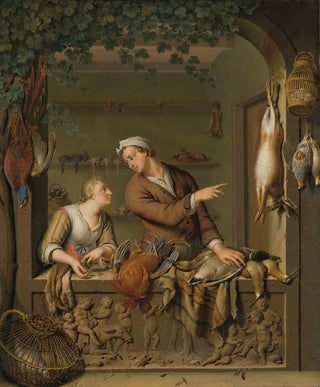Art print | The Poultry Seller - Willem van Mieris


View from behind

Frame (optional)
In the fascinating world of art, some works manage to capture the essence of everyday life with such precision that they transcend their era. "The Poultry Seller" by Willem van Mieris is a perfect example. This painting, which evokes the hustle and bustle of lively 17th-century markets, immerses us in a vibrant scene where colors and textures blend to bring a fleeting moment to life. The artist, a true master of light and shadow, succeeds in creating an atmosphere that is both realistic and poetic, inviting the viewer to step into this stolen moment from the routine of merchants.
Style and uniqueness of the work
The uniqueness of "The Poultry Seller" lies in van Mieris's ability to combine striking realism with an almost lyrical delicacy. Every detail, from the feathers of the poultry to the expressions of the characters, is treated with meticulous care that reflects a deep respect for the subject. The composition is carefully balanced, highlighting the seller at the center of the canvas, while intrigued customers crowd around him. The color palette, rich and nuanced, evokes the warmth of a market in broad daylight, while the subtly measured light plays on surfaces and emphasizes the three-dimensionality of the forms. This work does not merely depict a scene; it tells a story, that of an exchange, a transaction, but also of a vibrant social life, where each character seems animated by a personal intention.
The artist and his influence
Willem van Mieris, born in 1662 in Leiden, is often regarded as one of the masters of Dutch genre painting. Son of a painter, he developed a style that is uniquely his own, influenced by the greats of his time, such as Jan Steen and Frans van Mieris, his father. His work is distinguished by a particular attention to detail and a capacity to capture humanity in his everyday scenes. Van Mieris also skillfully incorporated elements of morality and satire into his compositions, offering a reflection on the society of his time. His influence endures, inspiring

Matte finish

View from behind

Frame (optional)
In the fascinating world of art, some works manage to capture the essence of everyday life with such precision that they transcend their era. "The Poultry Seller" by Willem van Mieris is a perfect example. This painting, which evokes the hustle and bustle of lively 17th-century markets, immerses us in a vibrant scene where colors and textures blend to bring a fleeting moment to life. The artist, a true master of light and shadow, succeeds in creating an atmosphere that is both realistic and poetic, inviting the viewer to step into this stolen moment from the routine of merchants.
Style and uniqueness of the work
The uniqueness of "The Poultry Seller" lies in van Mieris's ability to combine striking realism with an almost lyrical delicacy. Every detail, from the feathers of the poultry to the expressions of the characters, is treated with meticulous care that reflects a deep respect for the subject. The composition is carefully balanced, highlighting the seller at the center of the canvas, while intrigued customers crowd around him. The color palette, rich and nuanced, evokes the warmth of a market in broad daylight, while the subtly measured light plays on surfaces and emphasizes the three-dimensionality of the forms. This work does not merely depict a scene; it tells a story, that of an exchange, a transaction, but also of a vibrant social life, where each character seems animated by a personal intention.
The artist and his influence
Willem van Mieris, born in 1662 in Leiden, is often regarded as one of the masters of Dutch genre painting. Son of a painter, he developed a style that is uniquely his own, influenced by the greats of his time, such as Jan Steen and Frans van Mieris, his father. His work is distinguished by a particular attention to detail and a capacity to capture humanity in his everyday scenes. Van Mieris also skillfully incorporated elements of morality and satire into his compositions, offering a reflection on the society of his time. His influence endures, inspiring






